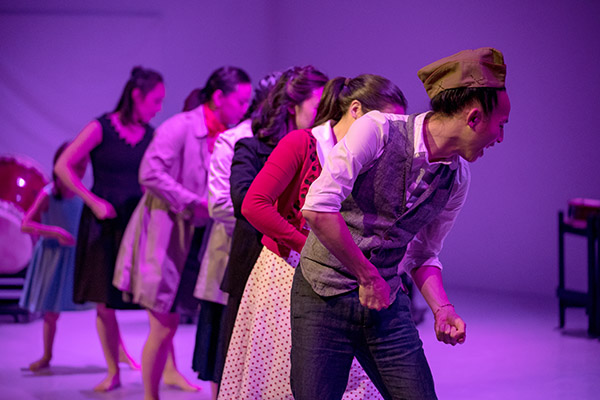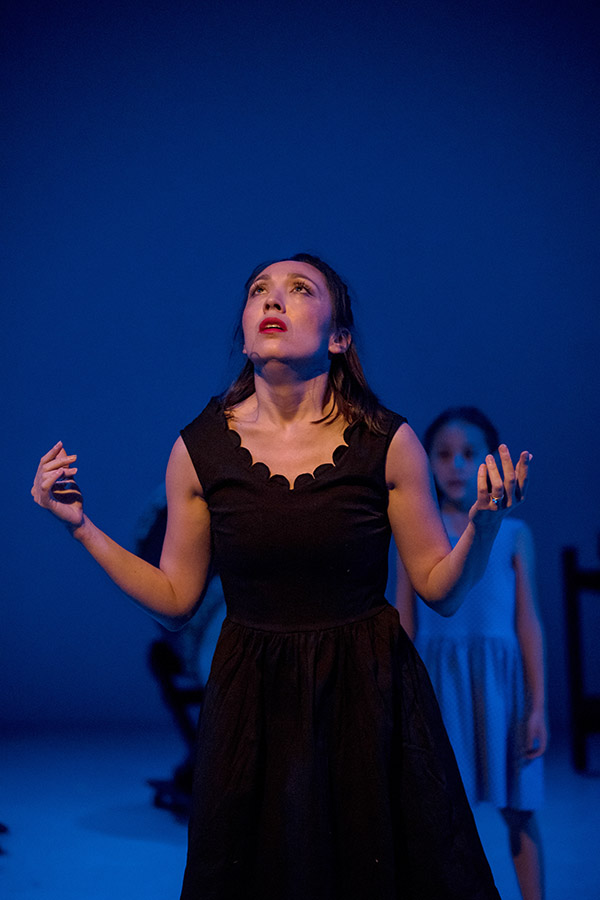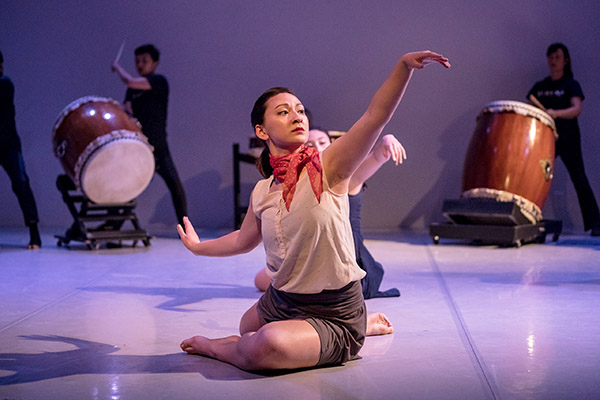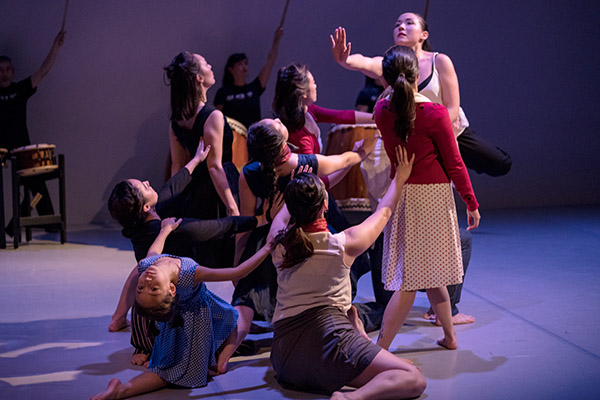Addressing Asian American History Through Dance
An Interview with Gabrielle Kazuko Nomura Gainor
BY EMMALY WIEDERHOLT; PHOTOS BY JOSEPH LAMBERT, JAZZY PHOTO
Gabrielle Kazuko Nomura Gainor is a Seattle-based dancer and choreographer. Her most recent piece, Farewell Shikata ga nai, is an ode to her Japanese family and community’s persecution in American concentration camps during WWII. Here, she discusses why it’s important to her to make dances about and for her Asian American community.
~~
Tell me a little about your dance history.
I’m a classically trained dancer in ballet and modern. I originally was pursuing a double major in dance and journalism at Western Washington University, but I realized I didn’t need a degree in dance to pursue it post-college, so I ended up just getting a degree in journalism and a minor in dance. Since 2010 when I graduated, I’ve danced professionally in the Seattle Area. I performed with Bellingham Repertory Dance right out of school, and I perform every year in this event called The Buttcracker. I also had my own troupe for six years called Relay Dance Collective. We had our last performance this past spring.
I should say I’m a new mom and I’m 30 now. Time is a lot more precious than it once was. I don’t have time to go to every audition or seek every opportunity, so I have to be very careful about what I choose to invest in. Moving forward in dance, I’m interested in exploring the Asian American experience. In my earlier years, I did a lot of dance in primarily white spaces. I’m really interested now in combining dance with Asian American theater and storytelling, as well as using my classical background, to make performances specifically for my Asian American community. This includes both the immigrant and mixed race Asian American community.
Why did you decide to make your most recent piece, Farewell Shikata ga nai?
I first created Farewell Shikata ga nai in 2014, and then revisited it this past spring for my company’s last show. I feel like I’ve lived a compartmentalized life in which I’m sometimes a dancer and sometimes an Asian American activist. When I first created the piece, it was an attempt at a synthesis of who I am. It coincided with my growing interest investigating what happened to Japanese Americans during World War II. My grandfather was born in an American concentration camp. I’m very close to my grandpa, and he’s also an Asian American activist. My closeness to him and the stories he told me while growing up made me want to connect to the Japanese American community’s legacy and experience. A lot of people choreograph about things close to their heart. This is the story that was burning inside me to tell.
It’s an all Asian American cast, both in 2014 and when I redid it this year. There’s also live music by a local taiko drumming group, Seattle Kokon Taiko. Not everyone in the cast is Japanese American, and there are folks of mixed race in the cast too, but we all relate to the material from the immigrant perspective.
The piece includes classical dance choreography. I wanted it to have an accessible look to it, since it’s not only for dance audiences but also for communities who aren’t used to seeing dance. There’s spoken text in it as well. A fellow JACL [Japanese American Citizens League] board member attended a conference called The Power of Words, which was an effort to change the euphemisms we use to talk about the WWII Japanese American incarceration. History books say, “They were interned,” or, “They went to camp,” but the truth is they were forcibly removed from their homes and incarcerated. The spoken text in the piece gets rid of the denial and speaks truth to what really happened. Shikata ga nai means “it can’t be helped,” as if there’s nothing to be done, which was an attitude Japanese Americans frequently had during WWII. For me to say, “Farewell Shikata ga nai” is an act of defiance to what my community accepted 70 years ago. It’s unacceptable what happened to them. The dance with the text and live taiko drumming is incredibly powerful. Some dancers perform as ancestors, so there’s this reconciliation with the past to move into the future with love and respect for what my elders went through, and also a determination never to let it happen again.
What was the process combining dance, text and taiko drumming?
I have taken a couple introductory taiko drumming classes and have always loved it as an audience member as well. There’s something about it that pounds; you can feel its vibrations in your heart. Farewell Shikata ga nai deals a lot with anger and release. Having had the visceral experience enjoying taiko drumming, I knew that any story I wanted to tell about the WWII incarceration would have to involve Taiko drumming. When I thought about how to tell a story that was immediate, accessible and speaks to people, taiko drumming was such a natural vehicle to create impact.
In terms of the text, I also am a writer and I have a degree in journalism. I wanted to use all my artistic mediums at my disposal. Combining dance and writing felt natural. When I choreograph in general, there’s usually an element of text or multimedia.
Why does this piece feel important now?
For so many reasons. Politically, it’s a little scary how important it is considering our current administration. We’re living in a time where it’s happening all over again. Migrant families are being separated from one another. There’s the Muslim ban. A buzz phrase being circulated in the Japanese American community is, “Never again is now.” We tell the story of what happened to us in WWII so that it will never happen again, but the shameful and horrific reality is that it is happening again. If I really care about my country and what my elders and ancestors went through, I have an obligation to continue to tell their story and also to speak out against our current political climate. What my grandfather and great grandparents went through was a sacrifice so that I can be an American and be proud of my Japanese heritage. They felt forced to assimilate and not make waves. Because of them, we, the younger generations, know that protest and acts of defiance are also patriotic. All the art that I’m making is done with a deep reverence and respect for my community. It goes to the core of my being.
What kinds of audiences have your performed Farewell Shikata ga nai for?
It premiered with my company in 2014 and again in 2018 for typical Seattle dance audiences. Outside of the dance realm, it was performed at the Wing Luke Museum of the Asian Pacific American Experience, located in Seattle’s international district. It was also performed at the Seattle Cherry Blossom Festival, at API Heritage Month, and at Pride ASIA. I recently got a $5,000 legacy grant through the Seattle JACL to perform it in 2019 in schools. There’s also some talks about taking it to Canada.
In the different spaces in which you’ve presented, were kinds of reactions have you received?
All the reactions were pretty positive. In the general dance audiences, a lot of people don’t know as much about what happened to Japanese Americans, so I received feedback that it was very powerful coming from an all Asian American cast. There’s also not a lot of taiko drumming in the contemporary dance scene, so I think that struck a chord. People have said it was different and refreshing. In the Asian spaces, I’ve also gotten positive feedback about the representation. Seeing all Asians dancing and performing is not something you see every day, so in both kinds of spaces the representation factor was powerful. I do not want to put down the amazing collaborators I’ve worked with of other races, but there is something that feeds my soul working and performing with Asian artists that no other experience captures.
Based on this experience, do you have ideas of where you might take your work from here?
My daughter Kiyomi is going to be 10 months old. Fresh off this last round of presenting Farewell Shikata ga nai, I got a lot of feedback that I should turn it into an evening length work. I have this wonderful troupe of Asian American performers ready to go, so it all feels at my fingertips, but I have to ask myself whether or not I can go after that. I definitely want to, but these moments with my daughter are so precious.
That being said, I’ve started playing around in the studio working on a new piece with a dancer with whom I’ve collaborated before, Truong Nguyen. He’s also a drag artist and boylesque performer, Miss Saigon Brown. As I’ve said, I’m interested in exploring the Asian American experience through dance for Asian American audiences. I would like to continue to perform Farewell Shikata ga nai in addition to creating other Asian American works. I’m mixed race as is my daughter, so it’s important for me to create stories that nourish and give visibility to our mixed, complex, experiences, as well as the experiences of my mixed family and collaborators. I should say that Farewell Shikata ga nai is also inter-generational, so it’s additionally important for me to tell stories for different ages. I want to continue putting people from different ages and backgrounds within my community onstage.
I consider myself more of a storyteller, and dance happens to be one of the mediums I’m equipped with. I don’t feel bound by the confines of dance; I can think outside the box and find what best tells the story. Several people have said Farewell Shikata ga nai feels more like a play than a dance. I just want to continue to make powerful, magical, intersectional dance theater works, and continue to collaborate with different Asian American artists.
Any other thoughts?
Will I make the time? That’s definitely a concern. But this seems to be where the opportunities are for me, so I’d be a fool to not go forth. I want to set a good example for my daughter, because I want her to be very passionate about something, whether or not it’s what I’m passionate about. I want to show her that I have a strong identity and lead by example. Ultimately, I want to create stories where she can see herself on stage. That’s not something I had growing up. Dance projects in my 30s will be fewer and far between, but hopefully more meaningful and impactful, and very Asian.
~~
To learn more, visit gabriellekazuko.weebly.com/farewell-shikata-ga-nai.




